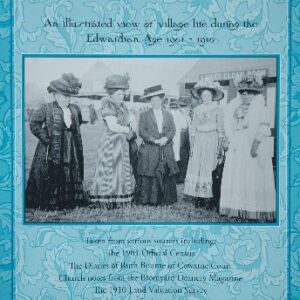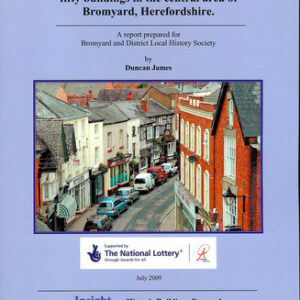Description
Compiled by the Bromyard & District History Society
Anyone interested in local history can now gaze into Bromyard’s past in a book of photographs. “Bromyard’s Victorian Heritage” compiled by Bromyard History Society has over a hundred images from 1880-1920. It shows town scenes and has sections on toll houses, schools, transport and sport. Diana Kelly, who helped to organize the book, said: “It just gives people the idea of what the town was like years ago.”
The Introduction
The Bromyard and District Local History Society, formed in 1966 to research and record the history of the town and its surrounding rural district, has from the beginning collected old photographs. The acquisition of several collections from local residents led to the publication in 1979 of ‘Bromyard: the day before yesterday’, a book of photographs covering the period 1880-1920. This has been out of print for some years and we were encouraged, when planning the Victorian Exhibition in 2004, to consider a replacement.
This book covers roughly the same period and concentrates on the development of the town. It does not cover the First World War which we felt needed its own history. We have used many of the same photographs, but not always in the same context. Some of the prints date back to the 1860s, some are prints from glass negatives which are less than perfect and a few have suffered some wear and tear, but they have been included because we feel the information they present is valuable. The majority were taken at the end of the 19th century when the hand-held camera made photography a popular activity. Local postcards also became available at this time and we have included some of these. There are no studio photographs and, regrettably, only one interior.
The tour of Bromyard with which the book begins covers an area only very slightly larger than the white area of the 1844 map on the back cover. Apart from the changes caused by the building of the 1967 by-pass, the street pattern shown has remained the same to the present day, although some buildings have been demolished and replaced and some streets have different names. Broad Street in 1905 looks very like Broad Street in 2005 even with the Falcon Hotel covered in plaster.
In contrast to this stability some of the major 19th century developments have left few traces. The railway, so important for Bromyard’s business life during the period of this book, closed in the 1960s and the site is now a trading estate. The two gas-works which supplied the town with gas for more than a hundred years from 1856 have both disappeared, the earlier building during the construction of the by-pass, and the later one when the site was sold in the early 1960s. The house built for the manager of the gas-works can still be seen near Broadbridge. More important than these, the market closed in the 1970s, leaving only the traces described on Page 22. Bromyard had held markets for a thousand years, a necessary hub for the surrounding district before modern transport allowed people to travel more widely.
In the transport section of the book we have also travelled, using photographs taken in the town where possible, but adding others from the wider area when necessary.
When ‘Bromyard: the day before yesterday’ was published there were still some residents who were born during the reign of Queen Victoria. This is not the case today and our information must come from other sources. The Society’s holdings are substantial and constantly updated, but there are gaps. If any reader knows where we can obtain a 19th century photograph of the racecourse or the Friends Meeting house we would be delighted.






